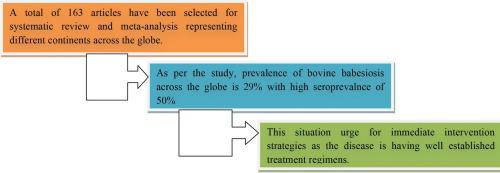Veterinary Parasitology ( IF 2.0 ) Pub Date : 2020-05-18 , DOI: 10.1016/j.vetpar.2020.109136 Siju Susan Jacob 1 , Pinaki Prasad Sengupta 1 , Krishnamoorthy Paramanandham 1 , Kuralayanapalya Puttahonnappa Suresh 1 , Jayantha Kumar Chamuah 2 , Gudepalya Renukaiah Rudramurthy 1 , Parimal Roy 1

|
Bovine babesiosis is continuing as a great threat to the livestock sector causing havoc production losses with significant morbidity and mortality. Being a tick-borne disease, the great complexity in the agent-host- vector relationship has severely hampered the sincere efforts towards the development of an effective vaccine against bovine babesiosis. In these circumstances, assessing the global scenario of disease prevalence is a prerequisite to strategize the available control measures. Keeping this in view, the objective of this study was to estimate the pooled prevalence of bovine babesiosis globally. The literature search was conducted to identify all relevant published articles reporting the prevalence of bovine babesiosis and a total of 163 studies were found eligible for final systematic review and meta-analysis. Meta-analysis was conducted using meta package of R software and summary estimates of the prevalence were calculated. Meta analysis of 81099 samples from 62 countires representing six continents revealed pooled global prevalence of bovine babesiosis as 29% (95% CI = 24%–34%) with estimated prevalence of active infection as 16% (95% CI = 13%–20%) and seroprevalence as 50% (95% CI = 45%–56%) using random effects model. Continent wise highest prevalence of bovine babesiosis in South America 64% (95% CI = 49%–77%) and lowest in Asia 19% (95% CI = 14%–25%). Highest prevalence was estimated with B. bigemina 22% (95% CI = 18%–27%) and least prevalence was recorded with B. divergens 12% (95% CI = 2%–46%). The pooled prevalence estimates generated in the study is revealing an increase in disease trend and the need for immediate planning of mitigation strategies paralleled with the development of early diagnostic methods to reduce the impact of disease throughout the world.
中文翻译:

牛杆状杆菌病:通过系统评价和荟萃分析,深入了解疾病分布的全球视角。
牛杆状杆菌病继续对畜牧业构成巨大威胁,造成严重的发病率和死亡率,造成严重的生产损失。作为壁虱传播的疾病,病原体与宿主之间的高度复杂性严重阻碍了为开发针对牛杆状病毒病的有效疫苗而做出的真诚努力。在这种情况下,评估全球疾病流行率是制定可用控制措施战略的前提。考虑到这一点,本研究的目的是估计全球牛杆状杆菌病的合并患病率。进行了文献检索,以鉴定出所有报告牛乳杆菌病患病率的相关发表文章,共发现163项研究符合最终系统评价和荟萃分析的条件。使用R软件的meta软件包进行荟萃分析,并计算患病率的汇总估计值。对代表六大洲的62个国家的81099个样本进行的荟萃分析显示,全球合并的牛巴西贝西斯病患病率为29%(95%CI = 24%–34%),而估计的活动性感染率为16%(95%CI = 13%-20)使用随机效应模型,血清阳性率为50%(95%CI = 45%–56%)。南美明智的牛幼虫病流行率最高,为64%(95%CI = 49%–77%),而在亚洲最低,为19%(95%CI = 14%–25%)。最高患病率估计为 对代表六大洲的62个国家的81099个样本进行的荟萃分析显示,全球合并的牛巴西贝西斯病患病率为29%(95%CI = 24%–34%),而估计的活动性感染率为16%(95%CI = 13%-20)使用随机效应模型,血清阳性率为50%(95%CI = 45%–56%)。南美明智的牛幼虫病流行率最高,为64%(95%CI = 49%–77%),而在亚洲最低,为19%(95%CI = 14%–25%)。最高患病率估计为 对代表六大洲的62个国家的81099个样本进行的荟萃分析显示,全球合并的牛巴西贝西斯病患病率为29%(95%CI = 24%–34%),而估计的活动性感染率为16%(95%CI = 13%-20)使用随机效应模型,血清阳性率为50%(95%CI = 45%–56%)。南美明智的牛幼虫病流行率最高,为64%(95%CI = 49%–77%),而在亚洲最低,为19%(95%CI = 14%–25%)。最高患病率估计为B. bigemina 22%(95%CI = 18%-27%)中,并记录有至少患病B. divergens 12%(95%CI = 2%-46%)。该研究中汇总的患病率估计值表明,疾病趋势有所增加,需要立即制定缓解策略,同时需要开发早期诊断方法以降低全世界疾病的影响。











































 京公网安备 11010802027423号
京公网安备 11010802027423号